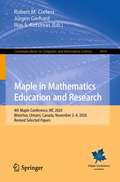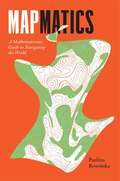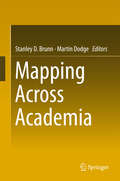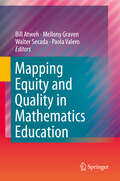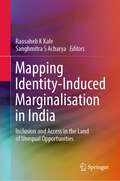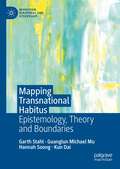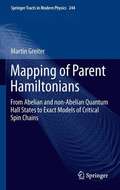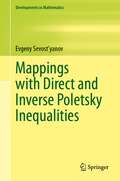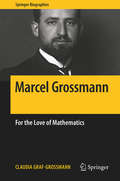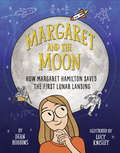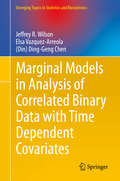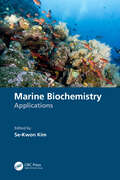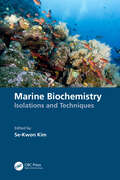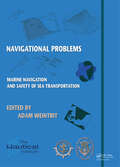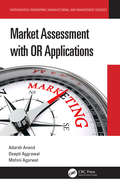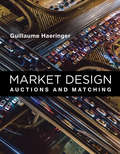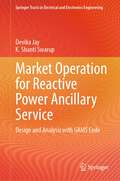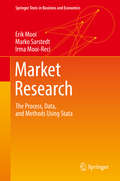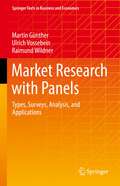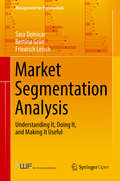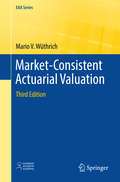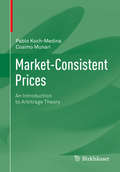- Table View
- List View
Maple in Mathematics Education and Research: 4th Maple Conference, MC 2020, Waterloo, Ontario, Canada, November 2–6, 2020, Revised Selected Papers (Communications in Computer and Information Science #1414)
by Ilias S. Kotsireas Jürgen Gerhard Robert M. CorlessThis book constitutes refereed proceedings of the 4th Maple Conference, MC 2020, held in Waterloo, Ontario, Canada, in November 2020. The 25 revised full papers and 3 short papers were carefully reviewed and selected out of 75 submissions, one invited paper is also presented in the volume. The papers included in this book cover topics in education, algorithms, and applciations of the mathematical software Maple.
Mapmatics: A Mathematician's Guide to Navigating the World
by Paulina Rowińska“I love maps. I love math. And gosh, do I love this book, which so beautifully and clearly sounds the depths of both.” —Ben Orlin, author of Math with Bad DrawingsExplore the surprising connections between math and maps—and the myriad ways they’ve shaped our world and us.Why are coastlines and borders so difficult to measure? How does a UPS driver deliver hundreds of packages in a single day? And where do elusive serial killers hide? The answers lie in the crucial connection between maps and math.In Mapmatics, mathematician Paulina Rowińska leads us on a riveting journey around the globe to discover how maps and math are deeply entwined, and always have been. From a sixteenth-century map, an indispensable navigation tool that exaggerates the size of northern countries, to public transport maps that both guide and confound passengers, to congressional maps that can empower or silence whole communities, she reveals how maps and math have shaped not only our sense of space but our worldview. In her hands, we learn how to read maps like a mathematician—to extract richer information and, just as importantly, to question our conclusions by asking what we don’t see.Written with authority and compassion, wit and unforgettable storytelling, this is math exposition at its best. By unpacking the math behind the maps we depend on, Mapmatics illuminates how our world works and, ultimately, how we can better look after it.
Mapping Across Academia
by Stanley D. Brunn Martin DodgeThis book addresses the role and importance of space in the respective fields of the social sciences and the humanities. It discusses how map representations and mapping processes can inform ongoing intellectual debates or open new avenues for scholarly inquiry within and across disciplines, including a wide array of significant developments in spatial processes, including the Internet, global positioning system (GPS), affordable digital photography and mobile technologies. Last but not least it reviews and assesses recent research challenges across disciplines that enhance our understanding of spatial processes and mapping at scales ranging from the molecular to the galactic.
Mapping Equity and Quality in Mathematics Education
by Paola Valero Mellony Graven Bill Atweh Walter SecadaConcerns about quality mathematics education are often posed in terms of the types of mathematics that are worthwhile and valuable for both the student and society in general, and about how to best support students so that they can develop this mathematics. Concerns about equity are about who is excluded from the opportunity to develop quality mathematics within our current practices and systems, and about how to remove social barriers that systematically disadvantage those students. This collection of chapters summarises our learning about the achievement of both equity and quality agendas in mathematics education and to move forward the debate on their importance for the field.
Mapping Identity-Induced Marginalisation in India: Inclusion and Access in the Land of Unequal Opportunities
by Raosaheb K Kale Sanghmitra S AcharyaThis book discusses the issues of inequality and marginalization in India. The first section of the book contextualizes sociological traditions for the scrutiny of subaltern discourse on discrimination. The chapters in the section explore self-identity, ‘margins’ in sociological traditions, subalternity and exclusion, citizenship issues of de-notified tribes, the role of religion for scheduled tribe Dalits and Ambedkar’s ideas on tribes. The second section deals with the political economy of higher education, health and employment. The efforts of BR Ambedkar and the consequences of those efforts, his critique of education policies during British time and its alteration for independent India have been meticulously dealt with. The third section illustrates an application of theoretical understanding through narratives of labour bondage in Varanasi, sanitation workers in Mumbai and rickshaw pullers in Delhi. The last section establishes that unequal access to resources is a consequence of discrimination and marginalization induced by social identities. The book argues for equitable access to resources and opportunities to ensure health equity. The audience for this publication includes academics, researchers, health professionals, policymakers engaged with discrimination, exclusion, marginalization and inequity in health.
Mapping Transnational Habitus: Epistemology, Theory and Boundaries (Migration, Diasporas and Citizenship)
by Guanglun Michael Mu Garth Stahl Hannah Soong Kun DaiThis book surveys and critiques existing empirical and theoretical literature on the Bourdieu-informed concept of transnational habitus. The term "transnational” has been used widely in studies of migration research where it has allowed scholars to have a deeper understanding of the practices not only of migrants moving across national borders but also of agents taking positions in transnational spaces without necessarily criss-crossing different nation states. Focusing on the potential of transnational habitus as an analytical tool, the authors propose a model of transnational habitus to identify integral key factors for the operationalisation in research. Drawing on reflexivity, the authors analyse transnational selves and map transnational spaces of classification. Identifying strengths, inconsistencies and key problems in this rapidly developing body of literature, this interdisciplinary and international book will be of interest to students and scholars in sociology, anthropology, migration studies, cultural studies, human geography, as well as diaspora studies.
Mapping of Parent Hamiltonians
by Martin GreiterThis monograph introduces an exact model for a critical spin chain with arbitrary spin S, which includes the Haldane--Shastry model as the special case S=1/2. While spinons in the Haldane-Shastry model obey abelian half-fermi statistics, the spinons in the general model introduced here obey non-abelian statistics. This manifests itself through topological choices for the fractional momentum spacings. The general model is derived by mapping exact models of quantized Hall states onto spin chains. The book begins with pedagogical review of all the relevant models including the non-abelian statistics in the Pfaffian Hall state, and is understandable to every student with a graduate course in quantum mechanics.
Mapping of Parent Hamiltonians: From Abelian and non-Abelian Quantum Hall States to Exact Models of Critical Spin Chains (Springer Tracts in Modern Physics #244)
by Martin GreiterThis monograph introduces an exact model for a critical spin chain with arbitrary spin S, which includes the Haldane--Shastry model as the special case S=1/2. While spinons in the Haldane-Shastry model obey abelian half-fermi statistics, the spinons in the general model introduced here obey non-abelian statistics. This manifests itself through topological choices for the fractional momentum spacings. The general model is derived by mapping exact models of quantized Hall states onto spin chains. The book begins with pedagogical review of all the relevant models including the non-abelian statistics in the Pfaffian Hall state, and is understandable to every student with a graduate course in quantum mechanics.
Mappings with Direct and Inverse Poletsky Inequalities (Developments in Mathematics #78)
by Evgeny Sevost'yanovThe monograph is devoted to the use of the moduli method in mapping theory, in particular, the meaning of direct and inverse modulus inequalities and their possible applications. The main goal is the development of a modulus technique in the Euclidean space and some metric spaces (manifolds, surfaces, quotient spaces, etc.). Particular attention is paid to the local and boundary behavior of mappings, as well as to obtaining modulus inequalities for some classes. The reader is invited to familiarize himself with all the main achievements of the author, synthesized in this book. The results presented here are of a high scientific level, are new and have no analogues in the world with such a degree of generality.
Marcel Grossmann: For the Love of Mathematics (Springer Biographies)
by William D. Brewer Claudia Graf-GrossmannZurich, summer 1912. Albert Einstein has just returned from Prague to the city on the Limmat. He sends a plea for help to his former fellow student, the mathematician Marcel Grossmann (1878-1936), for he is in need of assistance with the mathematical calculations of his general theory of relativity. What then follows is one of the most fascinating chapters of science history, with far-reaching consequences for the lives of the two friends. Marcel Grossmann’s granddaughter paints here a picture of a fiery and many-talented scientist and patriot. She traces the influence of an entrepreneurial family during Germany’s rapid industrial expansion in the late 19th century. The family’s fluctuating fortunes take the story to the vibrant city of Budapest on the Danube; they enable readers to sense the pioneering spirit at Zurich’s young Polytechnic Institute (now ETH Zurich) – but also reflect the worries and hardships of the First World War and interwar years. The Foreword is written by Prof. Remo Ruffini, founder and president of the International Center for Relativistic Astrophysics and the Marcel Grossmann Meetings. Last but not least, an extensive contribution by Dr. Tilman Sauer offers a scientific-historical appreciation of Marcel Grossmann’s enduring contributions.
Margaret and the Moon
by Dean RobbinsA true story from one of the Women of NASA!Margaret Hamilton loved numbers as a young girl. She knew how many miles it was to the moon (and how many back). She loved studying algebra and geometry and calculus and using math to solve problems in the outside world. Soon math led her to MIT and then to helping NASA put a man on the moon! She handwrote code that would allow the spacecraft&’s computer to solve any problems it might encounter. Apollo 8. Apollo 9. Apollo 10. Apollo 11. Without her code, none of those missions could have been completed. Dean Robbins and Lucy Knisley deliver a lovely portrayal of a pioneer in her field who never stopped reaching for the stars.
Marginal Models in Analysis of Correlated Binary Data with Time Dependent Covariates (Emerging Topics in Statistics and Biostatistics)
by Jeffrey R. Wilson (Din) Ding-Geng Chen Elsa Vazquez-ArreolaThis monograph provides a concise point of research topics and reference for modeling correlated response data with time-dependent covariates, and longitudinal data for the analysis of population-averaged models, highlighting methods by a variety of pioneering scholars. While the models presented in the volume are applied to health and health-related data, they can be used to analyze any kind of data that contain covariates that change over time. The included data are analyzed with the use of both R and SAS, and the data and computing programs are provided to readers so that they can replicate and implement covered methods. It is an excellent resource for scholars of both computational and methodological statistics and biostatistics, particularly in the applied areas of health.
Marginal Revolution in Economics: A Reappraisal (Monographs in Mathematical Economics #6)
by Toru MaruyamaThis volume is devoted to a reappraisal of the Marginal Revolution on the occasion of its 150th anniversary. The year 1871 should be remembered as one of the most important turning points in the history of economics. W. S. Jevons, C. Menger, and L. Walras published epochal works at the very beginning of the 1870s. Although these works were written independently, they shared a common mathematical structure based on classical analysis. For this reason, the emergence of the trio is called the Marginal Revolution. Indeed, 1871 is the starting point of modern economics in the proper sense. In 1971, several academic conferences were held on the occasion of the 100th anniversary of the Revolution, which exerted the stimulating influence upon the historical researches into the Revolution. Now more than fifty years have passed since then. Economic theory has experienced further substantial changes in researchers’ central interest, the way of reasonings and the styles of description during this period. In view of the new achievements acquired in recent fifty years, it seems an indispensable task for us to review and reevaluate the Marginal Revolution based upon the present status of economics.We also keep in mind that some concepts and doctrines once discarded could reappear in a later stage of history in a more or less transfigured form. The introductory chapter will be a guide for readers not only from the economics community but also from the mathematics community.
Marine Biochemistry: Applications
by Se-Kwon KimThis book provides the latest comprehensive methods for isolation and other novel techniques for marine product development. Furthermore, this book offers knowledge on the biological, medical, and industrial applications of marine-derived medicinal food substances. There has been a tremendous increase in the products derived from marine organisms for commercial application in industries every year. Functional foods of medicinal value are particularly in demand as new technology allows the stabilization of natural ingredients and their availability in pure forms to solve various human diseases. Marine flora and fauna have essential elements and trace minerals that nurture various hormones produced in the endocrine system to regulate the respective metabolisms, thereby providing a safe and healthy life to humans. The overall presentation and clear demarcation of the contents by worldwide contributions is a novel entry point into the market of medicinal foods from the sea. The exploration of marine habitats for novel materials are discussed throughout the book. The exploration and exploitation of the biochemistry of sea flora and fauna are limited, and this book extends the research possibilities into numerous marine habitats. Various approaches for extracting and applying the flora and fauna are discussed. This book will be of value to researchers, marine biotechnologists, and medical practitioners, due to the vast information, as well as industrial and medical applications of marine substances all in one place.
Marine Biochemistry: Isolations and Techniques
by Se-Kwon KimThis book provides the latest comprehensive methods for isolation and other novel techniques for marine product development. Furthermore, this book offers knowledge on the biological, medical, and industrial applications of marine-derived medicinal food substances. There has been a tremendous increase in the products derived from marine organisms for commercial application in industries every year. Functional foods of medicinal value are particularly in demand as new technology allows the stabilization of natural ingredients and their availability in pure forms to solve various human diseases. Marine flora and fauna have essential elements and trace minerals that nurture various hormones produced in the endocrine system to regulate the respective metabolisms, thereby providing a safe and healthy life to humans. The overall presentation and clear demarcation of the contents by worldwide contributions is a novel entry point into the market of medicinal foods from the sea. The exploration of marine habitats for novel materials are discussed throughout the book. The exploration and exploitation of the biochemistry of sea flora and fauna are limited, and this book extends the research possibilities into numerous marine habitats. Various approaches for extracting and applying the flora and fauna are discussed. This book will be of value to researchers, marine biotechnologists, and medical practitioners, due to the vast information, as well as industrial and medical applications of marine substances all in one place.
Marine Navigation and Safety of Sea Transportation: Navigational Problems
by Adam WeintritThe TransNav 2013 Symposium held at the Gdynia Maritime University, Poland in June 2013 has brought together a wide range of participants from all over the world. The program has offered a variety of contributions, allowing to look at many aspects of the navigational safety from various different points of view. Topics presented and discussed at th
Market Assessment with OR Applications (Mathematical Engineering, Manufacturing, and Management Sciences)
by Adarsh Anand Deepti Aggrawal Mohini AgarwalThis book provides an understanding of the concept of marketing and its role in business and public organization including the need for scientific marketing analysis. It includes a variety of mathematical models applied for better decision making, promotional decisions in the presence of competition, and sales forecasting using an Operational Research (OR) approach. The book also provides a platform to academicians, practitioners, and researchers to gain understanding of marketing management concepts from an OR perspective. This book offers relevant, international perspectives on techniques for market assessment under one canopy. It will be helpful for those who want to gain insight into understanding the managerial aspects from an OR analyst point of view and is a collaboration that contains plenty of related and valuable techniques used in real-life problems faced by industries.
Market Design: Auctions and Matching (The\mit Press Ser.)
by Guillaume HaeringerA broad overview of market mechanisms, with an emphasis on the interplay between theory and real-life applications; examples range from eBay auctions to school choice.This book offers an introduction to market design, providing students with a broad overview of issues related to the design and analysis of market mechanisms. It defines a market as a demand and a supply, without specifying a price system or mechanism. This allows the text to analyze a broad set of situations—including such unconventional markets as college admissions and organ donation—and forces readers to pay attention to details that might otherwise be overlooked. Students often complain that microeconomics is too abstract and disconnected from reality; the study of market design shows how theory can help solve existing, real-life problems. The book focuses on the interplay between theory and applications. To keep the text as accessible as possible, special effort has been made to minimize formal description of the models while emphasizing the intuitive, with detailed explanations and resolution of examples. Appendixes offer general reviews of elements of game theory and mechanism design that are related to the themes explored in the book, presenting the basic concepts with as many explanations and illustrations as possible.The book covers topics including the basics of simple auctions; eBay auctions; Vickrey–Clarke–Groves auctions; keyword auctions, with examples from Google and Facebook; spectrum auctions; financial markets, with discussions of treasury auctions and IPOs; trading on the stock market; the basic matching model; medical match; assignment problems; probabilistic assignments; school choice; course allocation, with examples from Harvard and Wharton; and kidney exchange.
Market Operation for Reactive Power Ancillary Service: Design and Analysis with GAMS Code (Springer Tracts in Electrical and Electronics Engineering)
by K. Shanti Swarup Devika JayThis book provides a framework suitable for the design and analysis of market mechanisms suitable for reactive power ancillary service. The book focuses on the formulation of market mechanisms capable of handling the localized nature of reactive power. The book presents tools and methodologies to design a suitable market structure capable of handling the technical challenges associated with the reactive power market like localized nature or reactive power, voltage support requirement, reactive power reserve requirement, and coupling between active reactive power markets. The book also presents techniques suitable for analyzing the market efficiency of different market mechanisms for reactive power ancillary service. The key topics discussed in this book include the relevance and challenges of reactive power ancillary service; the design of market mechanisms; network partitioning techniques to handle the localized nature of reactive power; and analysis of market mechanisms for market efficiency. This book is helpful for researchers and graduate students to know about recent advances in this area. Practitioners find the book helpful for understanding how technological advances can be put into practice and learning from case studies that bring out practical challenges.
Market Research
by Erik Mooi Marko Sarstedt Irma Mooi-ReciThis book is an easily accessible and comprehensive guide which helps make sound statistical decisions, perform analyses, and interpret the results quickly using Stata. It includes advanced coverage of ANOVA, factor, and cluster analyses in Stata, as well as essential regression and descriptive statistics. It is aimed at those wishing to know more about the process, data management, and most commonly used methods in market research using Stata. The book offers readers an overview of the entire market research process from asking market research questions to collecting and analyzing data by means of quantitative methods. It is engaging, hands-on, and includes many practical examples, tips, and suggestions that help readers apply and interpret quantitative methods, such as regression, factor, and cluster analysis. These methods help researchers provide companies with useful insights.
Market Research with Panels: Types, Surveys, Analysis, and Applications (Springer Texts in Business and Economics)
by Raimund Wildner Martin Günther Ulrich VossebeinOne of the most important tasks of market research is to read market developments in such a way that one's own company can use them for its own purposes. Companies that fail to sound out the market quickly fall behind. To prevent this, panel data is being consulted in more and more industries. This book shows students and practitioners how to use panels to conduct market and product analyses. Among others, the book covers the following types of panels: retail, consumer, media, pharmaceutical, and agriculture. Readers can learn how to identify, extract, and analyze important information such as consumer buying behavior, market efforts of competitors, and general trends and developments in the market. The goal is for the reader to be able to structure marketing strategies according to the movements in the market.
Market Segmentation Analysis: Understanding It, Doing It, and Making It Useful (Management for Professionals)
by Sara Dolnicar Bettina Grün Friedrich LeischThis book is published open access under a CC BY 4.0 license.This open access book offers something for everyone working with market segmentation: practical guidance for users of market segmentation solutions; organisational guidance on implementation issues; guidance for market researchers in charge of collecting suitable data; and guidance for data analysts with respect to the technical and statistical aspects of market segmentation analysis. Even market segmentation experts will find something new, including an approach to exploring data structure and choosing a suitable number of market segments, and a vast array of useful visualisation techniques that make interpretation of market segments and selection of target segments easier. The book talks the reader through every single step, every single potential pitfall, and every single decision that needs to be made to ensure market segmentation analysis is conducted as well as possible. All calculations are accompanied not only with a detailed explanation, but also with R code that allows readers to replicate any aspect of what is being covered in the book using R, the open-source environment for statistical computing and graphics.
Market-Consistent Actuarial Valuation (EAA Series)
by Mario V. WüthrichThis is the third edition of this well-received textbook, presenting powerful methods for measuring insurance liabilities and assets in a consistent way, with detailed mathematical frameworks that lead to market-consistent values for liabilities.Topics covered are stochastic discounting with deflators, valuation portfolio in life and non-life insurance, probability distortions, asset and liability management, financial risks, insurance technical risks, and solvency. Including updates on recent developments and regulatory changes under Solvency II, this new edition of Market-Consistent Actuarial Valuation also elaborates on different risk measures, providing a revised definition of solvency based on industry practice, and presents an adapted valuation framework which takes a dynamic view of non-life insurance reserving risk.
Market-Consistent Prices: An Introduction to Arbitrage Theory
by Pablo Koch-Medina Cosimo MunariArbitrage Theory provides the foundation for the pricing of financial derivatives and has become indispensable in both financial theory and financial practice. This textbook offers a rigorous and comprehensive introduction to the mathematics of arbitrage pricing in a discrete-time, finite-state economy in which a finite number of securities are traded. In a first step, various versions of the Fundamental Theorem of Asset Pricing, i.e., characterizations of when a market does not admit arbitrage opportunities, are proved. The book then focuses on incomplete markets where the main concern is to obtain a precise description of the set of “market-consistent” prices for nontraded financial contracts, i.e. the set of prices at which such contracts could be transacted between rational agents.Both European-type and American-type contracts are considered. A distinguishing feature of this book is its emphasis on market-consistent prices and a systematic description of pricing rules, also at intermediate dates. The benefits of this approach are most evident in the treatment of American options, which is novel in terms of both the presentation and the scope, while also presenting new results.The focus on discrete-time, finite-state models makes it possible to cover all relevant topics while requiring only a moderate mathematical background on the part of the reader. The book will appeal to mathematical finance and financial economics students seeking an elementary but rigorous introduction to the subject; mathematics and physics students looking for an opportunity to get acquainted with a modern applied topic; and mathematicians, physicists and quantitatively inclined economists working or planning to work in the financial industry.
Marketing Analytics: Statistical Tools for Marketing and Consumer Behavior Using SPSS (Mastering Business Analytics)
by Erik Kostelijk José Marcos Carvalho de MesquitaMarketing Analytics provides guidelines in the application of statistics using IBM SPSS Statistics Software (SPSS) for students and professionals using quantitative methods in marketing and consumer behavior. With simple language and a practical, screenshot-led approach, the book presents 11 multivariate techniques and the steps required to perform analysis. Each chapter contains a brief description of the technique, followed by the possible marketing research applications. One of these applications is then used in detail to illustrate its applicability in a research context, including the needed SPSS commands and illustrations. Each chapter also includes practical exercises that require the readers to perform the technique and interpret the results, equipping students with the necessary skills to apply statistics by means of SPSS in marketing and consumer research. Finally, there is a list of articles employing the technique that can be used for further reading. This textbook provides introductory material for advanced undergraduate and postgraduate students studying marketing and consumer analytics, teaching methods along with practical software-applied training using SPSS. Support material includes two real data sets to illustrate the techniques’ applications and PowerPoint slides providing a step-by-step guide to the analysis and commented outcomes. Professionals are invited to use the book to select and use the appropriate analytics for their specific context.
